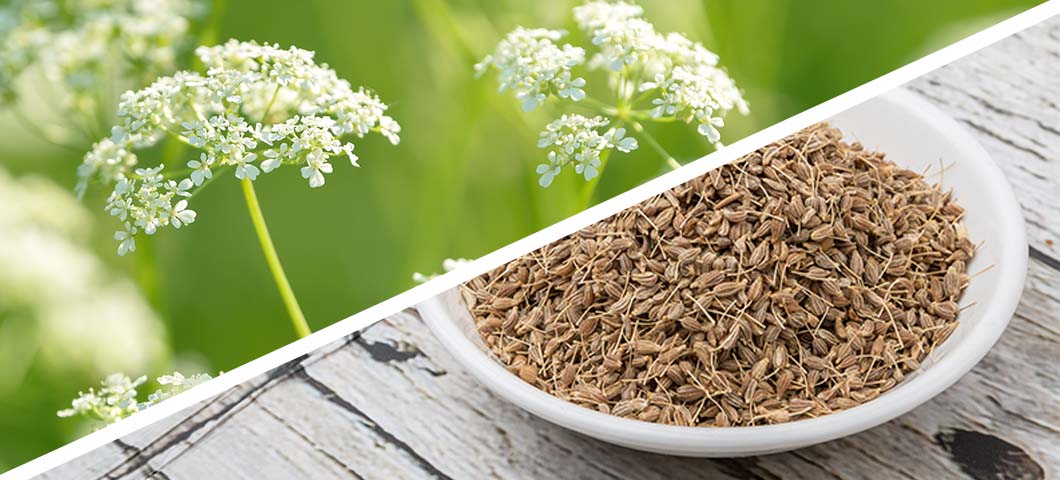Anise
(Pimpinella anisum L.)
Authors: Nancy W. Callan, Mal P. Westcott, James B. Miller, and Susan Wall-MacLane
Research Summary
Anise (Pimpinella anisum L.), a member of the carrot family, has long been valued for its fruits, commonly called seeds, and the oil that is distilled from them. Anise seed and oil has flavoring, cosmetic, and medicinal uses. The plant is native to Asia Minor and Egypt, and is cultivated in central, southern and eastern Europe, southern USSR, Macedonia, Syria, Tunis, Morocco, India, China, Chile and Mexico (1). Production is primarily from Turkey and China. World production of anise seed oil was estimated at $5,5 million in 1989 (2).
Anise is challenging to grow in Montana. A long, warm growing season of at least 120 frost-free days is required to ripen the seed (1). Seedlings are tolerant of frost, so the seed may be planted early. The plant requires good soil and sufficient water, and does poorly on dry, sandy soils or heavy, cool soils (3). Stand establishment may be difficult, as the seed germinates slowly and the seedlings are not competitive with weeds. Seeds should be harvested when they begin to turn gray. If the plant is cut and windrowed when the seeds are green, the seeds will continue to mature without shattering (1). Seed left too long on the plants becomes an undesirable black color. Reported yield of anise seed is 446 - 1338 lb/a (3).
The oil of anise is steam-distilled from the crushed seeds, which are 1.5-3% oil. Anise oil contains anethole (80-90%) and its isomer methyl chavicol. Anethole is crystalline below 15C, so oil high in anethole will congeal readily between 59 and 66F (1).
Anise was grown under irrigation at the Western Agricultural Research Center, Corvallis, MT. Anise was sown on May 5, 1999 and May 3, 2000 at 8.2 lb/acre in 8-row plots 15 ft long and rows 1 ft apart, with four replications. Seedling stand was 7.4 plants per foot in 1999. Seed was harvested September 27, 1999 and September 19, 2000. Border rows were not included. The air-dry seed was ground before steam distillation at the Northwestern Agricultural Research Center in 1999. Distillation was not done in 2000.
|
Harvest date
|
Seed (lb/a)
|
Oil (%)
|
Oil (lb/a)
|
Anethole (%)
|
|---|---|---|---|---|
|
September 27, 1999
|
1,112
|
0.79
|
10.0
|
91
|
|
September 19, 2000
|
1,149
|
|
|
|
Discussion
Yield of anise seed at WARC was acceptable in 1999 and 2000. Oil content was low, but anethole levels were high. This crop may have potential for a grower with rich soil, adequate water, and labor for weed control, as no herbicides are currently registered in the US. Propane flaming after seeding but before crop emergence may be a practical method of early weed control because anise seedling emergence is slower than that of many weeds. The market may be limited by competition from other anise-producing countries and from the star anise, which produces an oil with similar uses.
Acknowledgments
Seed was provided by Johnny's Selected Seeds Albion, ME. Oil analysis was performed by I. P. Callison and Sons, Chehalis, WA; Essex Laboratories, Inc., Salem, OR; and Wm. Leman Company, Bremen, IN.
References
- Guenther, E. 1948. The Essential Oils. Robert E. Krieger Pub. Co., Inc.
- Hay, R. K. M. and Waterman, P. G. 1993. Volatile Oil Crops: their Biology, Biochemistry, and Production. Longman Scientific and Technical, Essex, England.
- Hornok, L. 1992. Chichester, UK. Cultivation and Processing of Medicinal Plants. John Wiley and Sons.
- Simon, J.E., A.F. Chadwick and L.E. Craker. 1984. Herbs: An Indexed Bibliography. 1971-1980. The Scientific Literature on Selected Herbs, and Aromatic and Medicinal Plants of the Temperate Zone. Archon Books, 770 pp., Hamden, CT
- Simon, J. E. 1990. Essential Oils and Culinary Herbs. In: Janick, J. and Simon, J. E. (eds), Advances in New Crops. Timber Press, Portland, OR.


